University Finance Report: IFRS 16 Lease Accounting and IAS 16/IAS 2
VerifiedAdded on 2022/10/10
|20
|4262
|119
Report
AI Summary
This report provides a comprehensive overview of IFRS 16 lease accounting, detailing the treatment of leases by both lessees and lessors, including the classification of finance and operating leases. It examines the impact of lease accounting on financial statements and key financial ratios. The report also explores the differences between capital and revenue expenditures as per IAS 16, providing examples and explaining their accounting treatments. Furthermore, it covers the principles of inventory valuation according to IAS 2. The report includes an executive summary, table of contents, introduction, detailed discussions, and a conclusion, supported by relevant references.
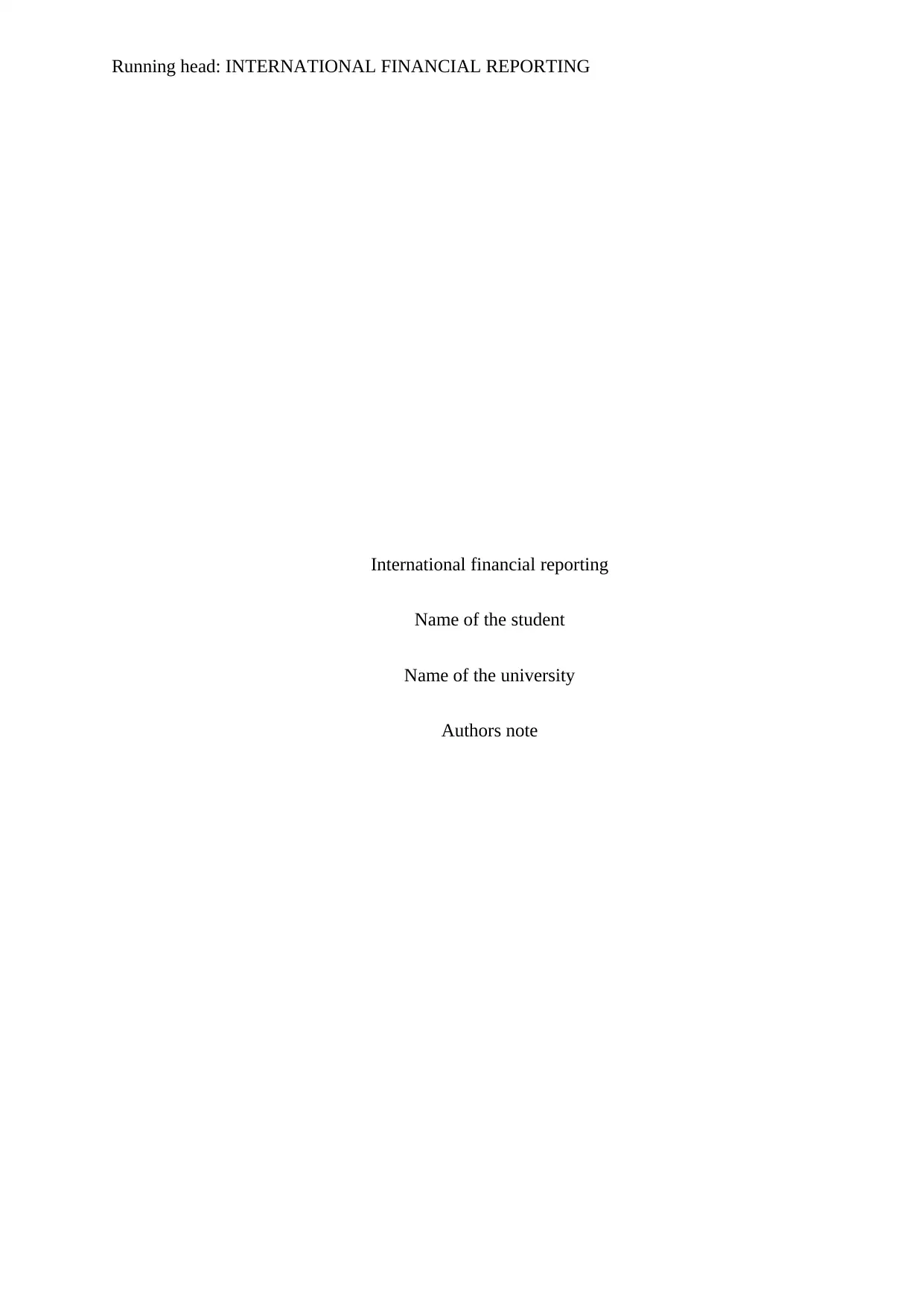
Running head: INTERNATIONAL FINANCIAL REPORTING
International financial reporting
Name of the student
Name of the university
Authors note
International financial reporting
Name of the student
Name of the university
Authors note
Paraphrase This Document
Need a fresh take? Get an instant paraphrase of this document with our AI Paraphraser
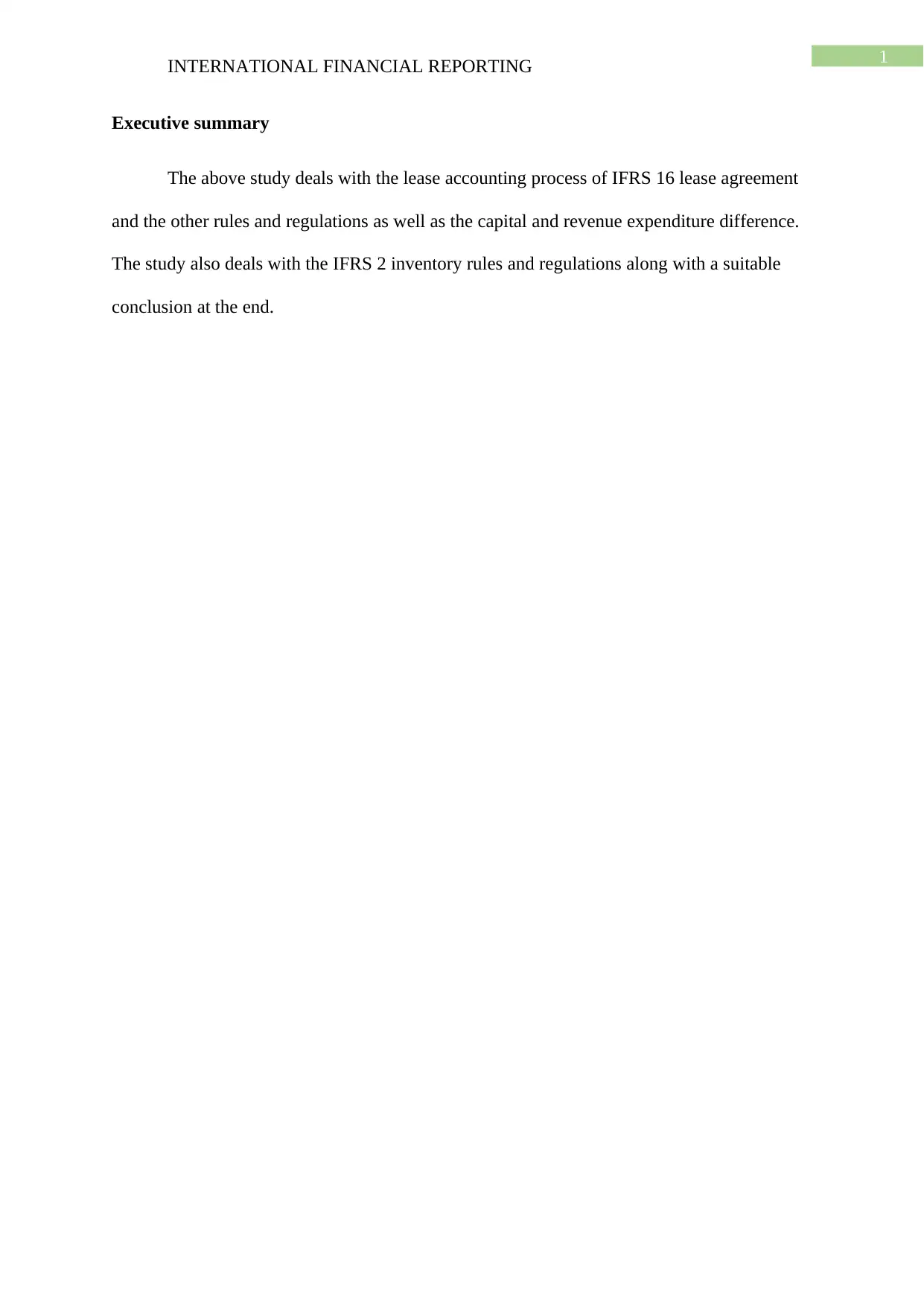
1
INTERNATIONAL FINANCIAL REPORTING
Executive summary
The above study deals with the lease accounting process of IFRS 16 lease agreement
and the other rules and regulations as well as the capital and revenue expenditure difference.
The study also deals with the IFRS 2 inventory rules and regulations along with a suitable
conclusion at the end.
INTERNATIONAL FINANCIAL REPORTING
Executive summary
The above study deals with the lease accounting process of IFRS 16 lease agreement
and the other rules and regulations as well as the capital and revenue expenditure difference.
The study also deals with the IFRS 2 inventory rules and regulations along with a suitable
conclusion at the end.

2
INTERNATIONAL FINANCIAL REPORTING
Table of Contents
Introduction....................................................................................................................4
Discussion......................................................................................................................4
Part 1- LEASE-IFRS 16/IFRS 17..............................................................................4
IFRS lease accounting treatment............................................................................4
Accounting by lease...................................................................................................5
Reporting by lessor for finance leases and operating leases as carried forward by
IAS 17....................................................................................................................................6
Accounting for financing for the lessee.....................................................................7
Accounting for operating lease by lessee...................................................................8
Impact of the lease accounting on the financial statement.........................................9
Impact of lease accounting on the lessee financial ratio............................................9
PART 2: PLANTS AND EQUIPMENT – IAS 16..................................................10
Difference between capital expenditure and revenue expenditure with example 10
Accounting treatment of machine expenditure as per IAS 16.................................12
PART 3 INVENTORIES – IAS 2............................................................................13
Determination of cost of inventory......................................................................13
Cost of inventory acquisition...................................................................................14
Measuring of cost.....................................................................................................15
Conclusion....................................................................................................................16
References....................................................................................................................17
Appendix......................................................................................................................20
INTERNATIONAL FINANCIAL REPORTING
Table of Contents
Introduction....................................................................................................................4
Discussion......................................................................................................................4
Part 1- LEASE-IFRS 16/IFRS 17..............................................................................4
IFRS lease accounting treatment............................................................................4
Accounting by lease...................................................................................................5
Reporting by lessor for finance leases and operating leases as carried forward by
IAS 17....................................................................................................................................6
Accounting for financing for the lessee.....................................................................7
Accounting for operating lease by lessee...................................................................8
Impact of the lease accounting on the financial statement.........................................9
Impact of lease accounting on the lessee financial ratio............................................9
PART 2: PLANTS AND EQUIPMENT – IAS 16..................................................10
Difference between capital expenditure and revenue expenditure with example 10
Accounting treatment of machine expenditure as per IAS 16.................................12
PART 3 INVENTORIES – IAS 2............................................................................13
Determination of cost of inventory......................................................................13
Cost of inventory acquisition...................................................................................14
Measuring of cost.....................................................................................................15
Conclusion....................................................................................................................16
References....................................................................................................................17
Appendix......................................................................................................................20
⊘ This is a preview!⊘
Do you want full access?
Subscribe today to unlock all pages.

Trusted by 1+ million students worldwide

3
INTERNATIONAL FINANCIAL REPORTING
Introduction
The above case study discusses the lease accounting treatment which had been
described in IFRS 1 and the same had been carried forward in the IAS 17 rule. The study also
described the lease accounting policy as per the financial assets and lease statements as
described in the IFRS 16. Further the study also discuss the difference between the capital
and revenue expenditure system and, the sufficient effects on the financial assets if the capital
expenditures are wrongly treated as revenue expenditure. Lastly the process of determining
the inventory has been made as per IFRS 2 with a suitable conclusion at the end.
Discussion
Part 1- LEASE-IFRS 16/IFRS 17
IFRS lease accounting treatment
IFR 16 specifies how an IFRS reporter will be able to recognise, measure, present and
disclose the lease volume. Hence the lease volume provides a single lease accounting model
which requires lease to recognise assets and liabilities for all the leases unless the lease term
is within 12 months or less or the asset has been undervalued. The lessors have continued to
classify leases for operating finance. Hence with the IFRS 16 approach to the lessor is
substantially less than the same had been unchanged by the predecessor in IFRS 17.
Objective
IFRS 16 establishes the principles for the recognition, measurement, presentation and
lease disclosure with an objective to ensure that lessor and the lessee tends to provide
equivalent information which faithfully represents those transactions.
Scope
INTERNATIONAL FINANCIAL REPORTING
Introduction
The above case study discusses the lease accounting treatment which had been
described in IFRS 1 and the same had been carried forward in the IAS 17 rule. The study also
described the lease accounting policy as per the financial assets and lease statements as
described in the IFRS 16. Further the study also discuss the difference between the capital
and revenue expenditure system and, the sufficient effects on the financial assets if the capital
expenditures are wrongly treated as revenue expenditure. Lastly the process of determining
the inventory has been made as per IFRS 2 with a suitable conclusion at the end.
Discussion
Part 1- LEASE-IFRS 16/IFRS 17
IFRS lease accounting treatment
IFR 16 specifies how an IFRS reporter will be able to recognise, measure, present and
disclose the lease volume. Hence the lease volume provides a single lease accounting model
which requires lease to recognise assets and liabilities for all the leases unless the lease term
is within 12 months or less or the asset has been undervalued. The lessors have continued to
classify leases for operating finance. Hence with the IFRS 16 approach to the lessor is
substantially less than the same had been unchanged by the predecessor in IFRS 17.
Objective
IFRS 16 establishes the principles for the recognition, measurement, presentation and
lease disclosure with an objective to ensure that lessor and the lessee tends to provide
equivalent information which faithfully represents those transactions.
Scope
Paraphrase This Document
Need a fresh take? Get an instant paraphrase of this document with our AI Paraphraser

4
INTERNATIONAL FINANCIAL REPORTING
There are various scopes for the lease, sublease. These are as follows-
Leases to explore the oil, minerals, natural gas and similar other kind of non-
generative products.
Leases of the biological assets are held by lease.
Service concessions arrangement.
Intellectual property licence granted by a lessor and the licencing agreements for
films, video, plays, and manuscripts, patient and copyrights also to be included in this case.
Lease identification
A lease contract contains a lease if the same can convey the right to control of the use
of any underlined asset for a period of exchange or consideration. Hence the control is
conveyed when the customer has the right to direct the identified asset use or systematically
specify all the economic benefits conveyed through it. An asset is typically conveyed to a
specified contract which is made available for the customers. hence when the suppliers has a
substantial right of substantial rights of substitution throughout the period remains the same,
there is a requirement for substantive alternative cost if the suppler have both the substitute
alterative assets which could be beneficial for substitution.
Accounting by lease
A lease recognises the right to issue for an asset as well as a lease liability. Hence the
right to use an asset is a lease liability cost which is a direct cost initiated by the lessee. Apart
from this there is also a lease incentive payment and commitment is made based on the
commencement of similar work. Hence after the lease commencement a lessee could measure
the right use of asset with a cost model.
INTERNATIONAL FINANCIAL REPORTING
There are various scopes for the lease, sublease. These are as follows-
Leases to explore the oil, minerals, natural gas and similar other kind of non-
generative products.
Leases of the biological assets are held by lease.
Service concessions arrangement.
Intellectual property licence granted by a lessor and the licencing agreements for
films, video, plays, and manuscripts, patient and copyrights also to be included in this case.
Lease identification
A lease contract contains a lease if the same can convey the right to control of the use
of any underlined asset for a period of exchange or consideration. Hence the control is
conveyed when the customer has the right to direct the identified asset use or systematically
specify all the economic benefits conveyed through it. An asset is typically conveyed to a
specified contract which is made available for the customers. hence when the suppliers has a
substantial right of substantial rights of substitution throughout the period remains the same,
there is a requirement for substantive alternative cost if the suppler have both the substitute
alterative assets which could be beneficial for substitution.
Accounting by lease
A lease recognises the right to issue for an asset as well as a lease liability. Hence the
right to use an asset is a lease liability cost which is a direct cost initiated by the lessee. Apart
from this there is also a lease incentive payment and commitment is made based on the
commencement of similar work. Hence after the lease commencement a lessee could measure
the right use of asset with a cost model.
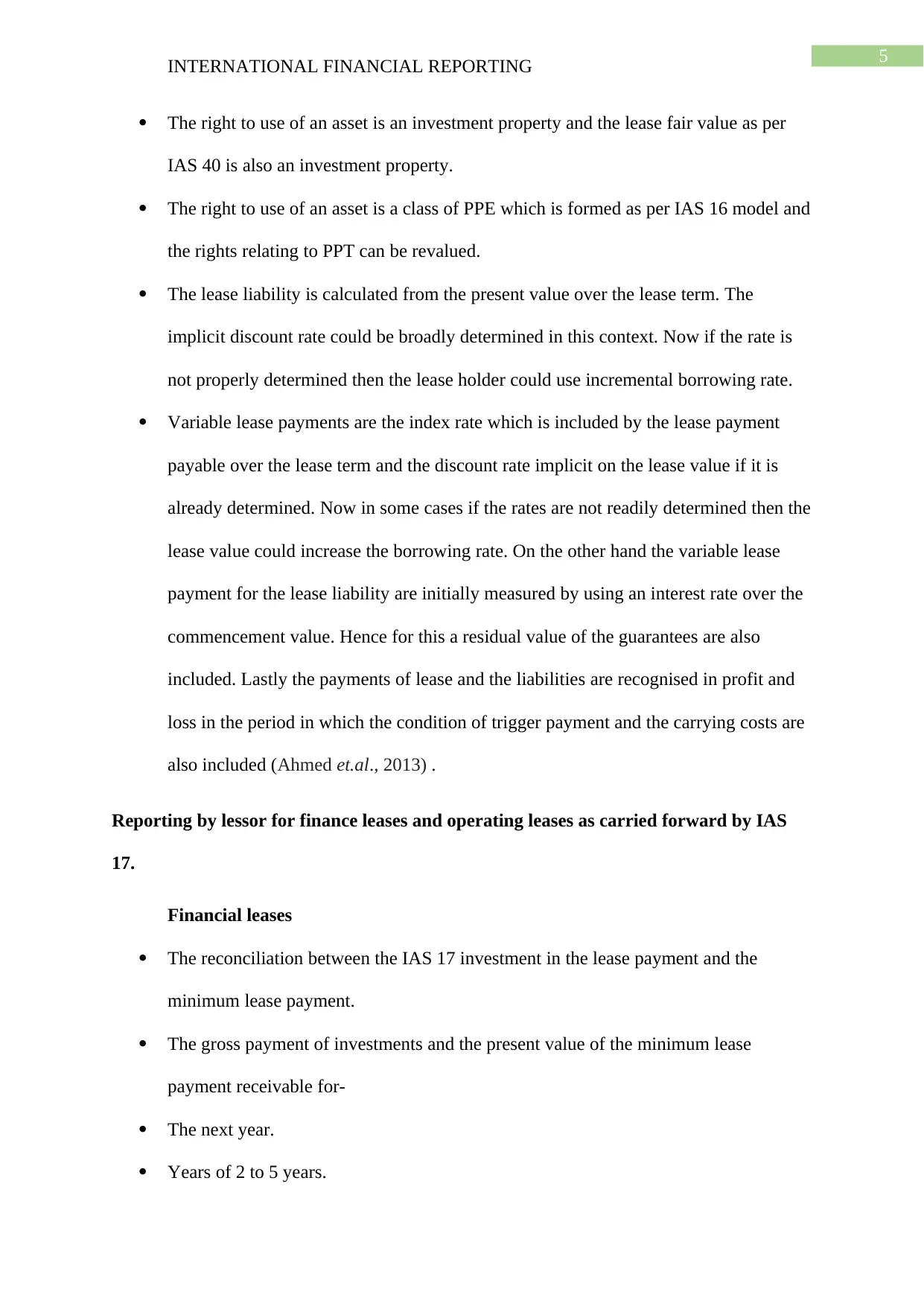
5
INTERNATIONAL FINANCIAL REPORTING
The right to use of an asset is an investment property and the lease fair value as per
IAS 40 is also an investment property.
The right to use of an asset is a class of PPE which is formed as per IAS 16 model and
the rights relating to PPT can be revalued.
The lease liability is calculated from the present value over the lease term. The
implicit discount rate could be broadly determined in this context. Now if the rate is
not properly determined then the lease holder could use incremental borrowing rate.
Variable lease payments are the index rate which is included by the lease payment
payable over the lease term and the discount rate implicit on the lease value if it is
already determined. Now in some cases if the rates are not readily determined then the
lease value could increase the borrowing rate. On the other hand the variable lease
payment for the lease liability are initially measured by using an interest rate over the
commencement value. Hence for this a residual value of the guarantees are also
included. Lastly the payments of lease and the liabilities are recognised in profit and
loss in the period in which the condition of trigger payment and the carrying costs are
also included (Ahmed et.al., 2013) .
Reporting by lessor for finance leases and operating leases as carried forward by IAS
17.
Financial leases
The reconciliation between the IAS 17 investment in the lease payment and the
minimum lease payment.
The gross payment of investments and the present value of the minimum lease
payment receivable for-
The next year.
Years of 2 to 5 years.
INTERNATIONAL FINANCIAL REPORTING
The right to use of an asset is an investment property and the lease fair value as per
IAS 40 is also an investment property.
The right to use of an asset is a class of PPE which is formed as per IAS 16 model and
the rights relating to PPT can be revalued.
The lease liability is calculated from the present value over the lease term. The
implicit discount rate could be broadly determined in this context. Now if the rate is
not properly determined then the lease holder could use incremental borrowing rate.
Variable lease payments are the index rate which is included by the lease payment
payable over the lease term and the discount rate implicit on the lease value if it is
already determined. Now in some cases if the rates are not readily determined then the
lease value could increase the borrowing rate. On the other hand the variable lease
payment for the lease liability are initially measured by using an interest rate over the
commencement value. Hence for this a residual value of the guarantees are also
included. Lastly the payments of lease and the liabilities are recognised in profit and
loss in the period in which the condition of trigger payment and the carrying costs are
also included (Ahmed et.al., 2013) .
Reporting by lessor for finance leases and operating leases as carried forward by IAS
17.
Financial leases
The reconciliation between the IAS 17 investment in the lease payment and the
minimum lease payment.
The gross payment of investments and the present value of the minimum lease
payment receivable for-
The next year.
Years of 2 to 5 years.
⊘ This is a preview!⊘
Do you want full access?
Subscribe today to unlock all pages.

Trusted by 1+ million students worldwide

6
INTERNATIONAL FINANCIAL REPORTING
Beyond 5 years.
Operating leases
The amount of the lease payments at the balance sheet date and under non concern
able operating leases in the aggregate and for
The next year.
Years 2 to 5 are combined.
And beyond 5 years.
Contingent rent recognised as an income.
General description of the significant leasing arrangement.
In this way the lease agreement rule have been converted into IAS 17.
A lessee uses the leased asset and makes regular payments. To the lessor. The
accounting and reporting of different leases are done as follows-
Accounting for financing for the lessee
The financial leases are been reported by the lessee does follow some differential statements-
Balance sheet
Both the leased asset and the lease payment of the liability have been reported. Hence
the value is reported is lower of the present value of the lease payment in the future over the
leased asset value is determined over the fair value of the asset.
Income statement
The interest expense on the lease payable is reported. Hence the calculated lease value
is payable at the beginning used in the leased interest period. Here the interest lease value is
INTERNATIONAL FINANCIAL REPORTING
Beyond 5 years.
Operating leases
The amount of the lease payments at the balance sheet date and under non concern
able operating leases in the aggregate and for
The next year.
Years 2 to 5 are combined.
And beyond 5 years.
Contingent rent recognised as an income.
General description of the significant leasing arrangement.
In this way the lease agreement rule have been converted into IAS 17.
A lessee uses the leased asset and makes regular payments. To the lessor. The
accounting and reporting of different leases are done as follows-
Accounting for financing for the lessee
The financial leases are been reported by the lessee does follow some differential statements-
Balance sheet
Both the leased asset and the lease payment of the liability have been reported. Hence
the value is reported is lower of the present value of the lease payment in the future over the
leased asset value is determined over the fair value of the asset.
Income statement
The interest expense on the lease payable is reported. Hence the calculated lease value
is payable at the beginning used in the leased interest period. Here the interest lease value is
Paraphrase This Document
Need a fresh take? Get an instant paraphrase of this document with our AI Paraphraser
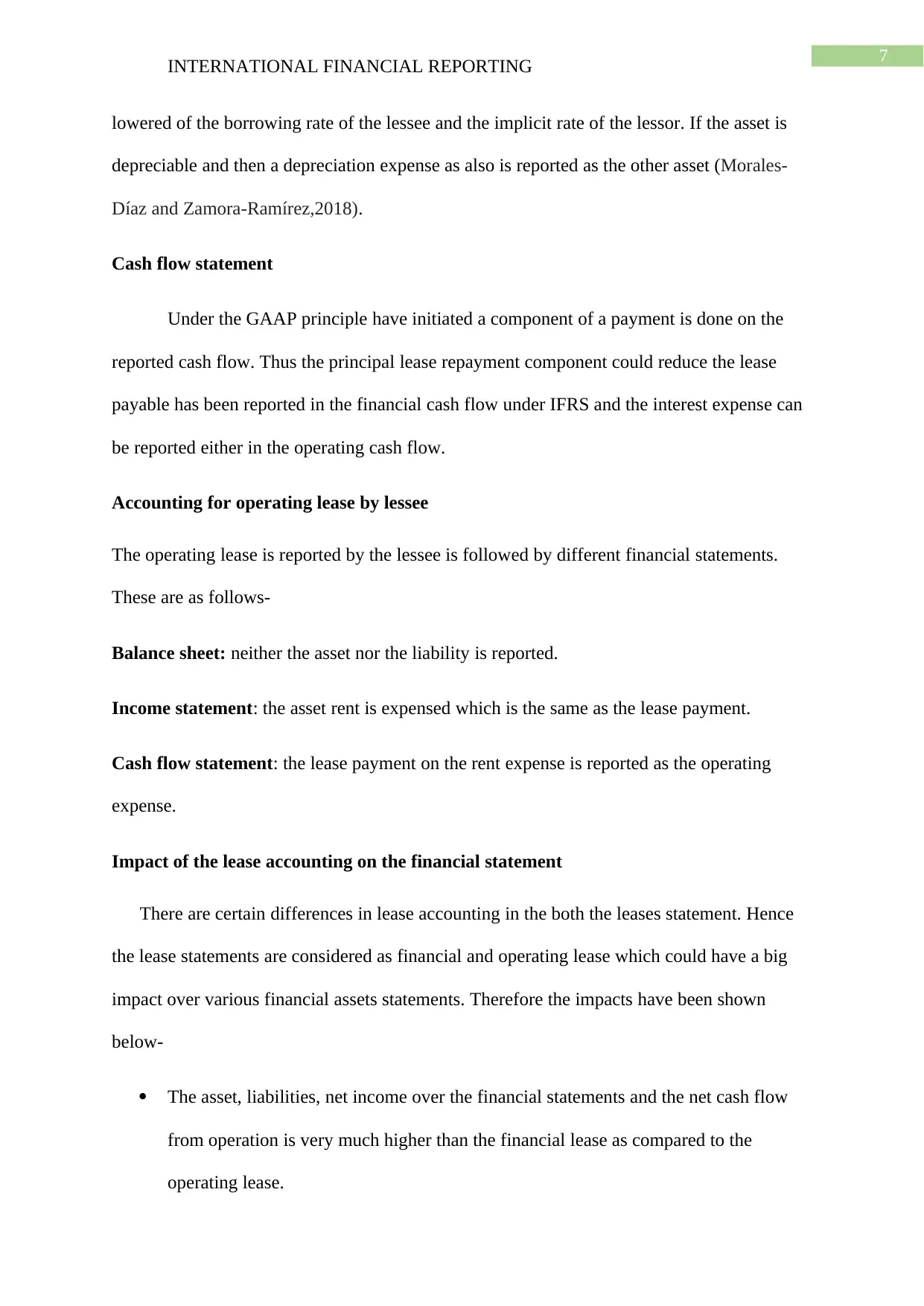
7
INTERNATIONAL FINANCIAL REPORTING
lowered of the borrowing rate of the lessee and the implicit rate of the lessor. If the asset is
depreciable and then a depreciation expense as also is reported as the other asset (Morales-
Díaz and Zamora-Ramírez,2018).
Cash flow statement
Under the GAAP principle have initiated a component of a payment is done on the
reported cash flow. Thus the principal lease repayment component could reduce the lease
payable has been reported in the financial cash flow under IFRS and the interest expense can
be reported either in the operating cash flow.
Accounting for operating lease by lessee
The operating lease is reported by the lessee is followed by different financial statements.
These are as follows-
Balance sheet: neither the asset nor the liability is reported.
Income statement: the asset rent is expensed which is the same as the lease payment.
Cash flow statement: the lease payment on the rent expense is reported as the operating
expense.
Impact of the lease accounting on the financial statement
There are certain differences in lease accounting in the both the leases statement. Hence
the lease statements are considered as financial and operating lease which could have a big
impact over various financial assets statements. Therefore the impacts have been shown
below-
The asset, liabilities, net income over the financial statements and the net cash flow
from operation is very much higher than the financial lease as compared to the
operating lease.
INTERNATIONAL FINANCIAL REPORTING
lowered of the borrowing rate of the lessee and the implicit rate of the lessor. If the asset is
depreciable and then a depreciation expense as also is reported as the other asset (Morales-
Díaz and Zamora-Ramírez,2018).
Cash flow statement
Under the GAAP principle have initiated a component of a payment is done on the
reported cash flow. Thus the principal lease repayment component could reduce the lease
payable has been reported in the financial cash flow under IFRS and the interest expense can
be reported either in the operating cash flow.
Accounting for operating lease by lessee
The operating lease is reported by the lessee is followed by different financial statements.
These are as follows-
Balance sheet: neither the asset nor the liability is reported.
Income statement: the asset rent is expensed which is the same as the lease payment.
Cash flow statement: the lease payment on the rent expense is reported as the operating
expense.
Impact of the lease accounting on the financial statement
There are certain differences in lease accounting in the both the leases statement. Hence
the lease statements are considered as financial and operating lease which could have a big
impact over various financial assets statements. Therefore the impacts have been shown
below-
The asset, liabilities, net income over the financial statements and the net cash flow
from operation is very much higher than the financial lease as compared to the
operating lease.
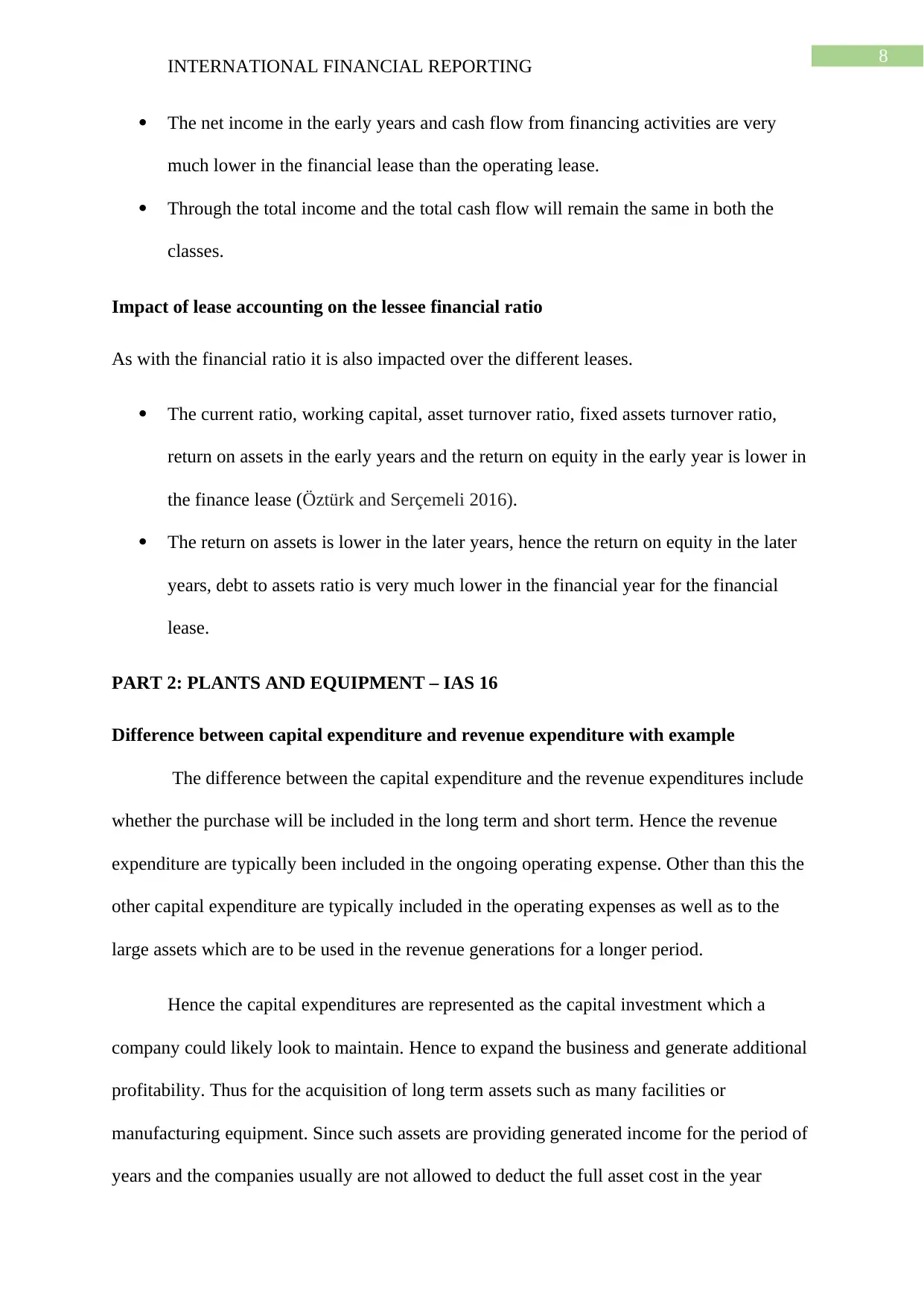
8
INTERNATIONAL FINANCIAL REPORTING
The net income in the early years and cash flow from financing activities are very
much lower in the financial lease than the operating lease.
Through the total income and the total cash flow will remain the same in both the
classes.
Impact of lease accounting on the lessee financial ratio
As with the financial ratio it is also impacted over the different leases.
The current ratio, working capital, asset turnover ratio, fixed assets turnover ratio,
return on assets in the early years and the return on equity in the early year is lower in
the finance lease (Öztürk and Serçemeli 2016).
The return on assets is lower in the later years, hence the return on equity in the later
years, debt to assets ratio is very much lower in the financial year for the financial
lease.
PART 2: PLANTS AND EQUIPMENT – IAS 16
Difference between capital expenditure and revenue expenditure with example
The difference between the capital expenditure and the revenue expenditures include
whether the purchase will be included in the long term and short term. Hence the revenue
expenditure are typically been included in the ongoing operating expense. Other than this the
other capital expenditure are typically included in the operating expenses as well as to the
large assets which are to be used in the revenue generations for a longer period.
Hence the capital expenditures are represented as the capital investment which a
company could likely look to maintain. Hence to expand the business and generate additional
profitability. Thus for the acquisition of long term assets such as many facilities or
manufacturing equipment. Since such assets are providing generated income for the period of
years and the companies usually are not allowed to deduct the full asset cost in the year
INTERNATIONAL FINANCIAL REPORTING
The net income in the early years and cash flow from financing activities are very
much lower in the financial lease than the operating lease.
Through the total income and the total cash flow will remain the same in both the
classes.
Impact of lease accounting on the lessee financial ratio
As with the financial ratio it is also impacted over the different leases.
The current ratio, working capital, asset turnover ratio, fixed assets turnover ratio,
return on assets in the early years and the return on equity in the early year is lower in
the finance lease (Öztürk and Serçemeli 2016).
The return on assets is lower in the later years, hence the return on equity in the later
years, debt to assets ratio is very much lower in the financial year for the financial
lease.
PART 2: PLANTS AND EQUIPMENT – IAS 16
Difference between capital expenditure and revenue expenditure with example
The difference between the capital expenditure and the revenue expenditures include
whether the purchase will be included in the long term and short term. Hence the revenue
expenditure are typically been included in the ongoing operating expense. Other than this the
other capital expenditure are typically included in the operating expenses as well as to the
large assets which are to be used in the revenue generations for a longer period.
Hence the capital expenditures are represented as the capital investment which a
company could likely look to maintain. Hence to expand the business and generate additional
profitability. Thus for the acquisition of long term assets such as many facilities or
manufacturing equipment. Since such assets are providing generated income for the period of
years and the companies usually are not allowed to deduct the full asset cost in the year
⊘ This is a preview!⊘
Do you want full access?
Subscribe today to unlock all pages.

Trusted by 1+ million students worldwide
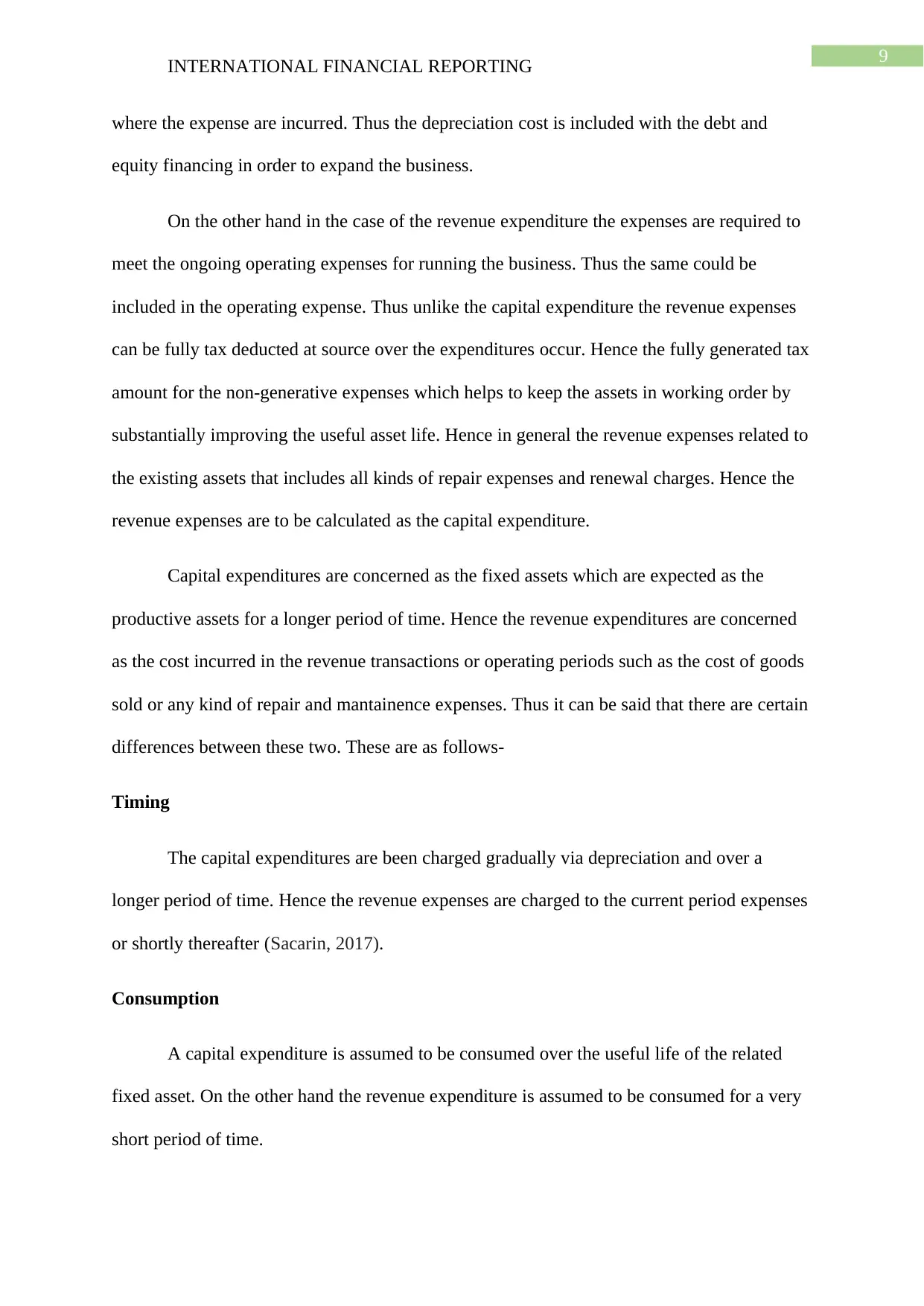
9
INTERNATIONAL FINANCIAL REPORTING
where the expense are incurred. Thus the depreciation cost is included with the debt and
equity financing in order to expand the business.
On the other hand in the case of the revenue expenditure the expenses are required to
meet the ongoing operating expenses for running the business. Thus the same could be
included in the operating expense. Thus unlike the capital expenditure the revenue expenses
can be fully tax deducted at source over the expenditures occur. Hence the fully generated tax
amount for the non-generative expenses which helps to keep the assets in working order by
substantially improving the useful asset life. Hence in general the revenue expenses related to
the existing assets that includes all kinds of repair expenses and renewal charges. Hence the
revenue expenses are to be calculated as the capital expenditure.
Capital expenditures are concerned as the fixed assets which are expected as the
productive assets for a longer period of time. Hence the revenue expenditures are concerned
as the cost incurred in the revenue transactions or operating periods such as the cost of goods
sold or any kind of repair and mantainence expenses. Thus it can be said that there are certain
differences between these two. These are as follows-
Timing
The capital expenditures are been charged gradually via depreciation and over a
longer period of time. Hence the revenue expenses are charged to the current period expenses
or shortly thereafter (Sacarin, 2017).
Consumption
A capital expenditure is assumed to be consumed over the useful life of the related
fixed asset. On the other hand the revenue expenditure is assumed to be consumed for a very
short period of time.
INTERNATIONAL FINANCIAL REPORTING
where the expense are incurred. Thus the depreciation cost is included with the debt and
equity financing in order to expand the business.
On the other hand in the case of the revenue expenditure the expenses are required to
meet the ongoing operating expenses for running the business. Thus the same could be
included in the operating expense. Thus unlike the capital expenditure the revenue expenses
can be fully tax deducted at source over the expenditures occur. Hence the fully generated tax
amount for the non-generative expenses which helps to keep the assets in working order by
substantially improving the useful asset life. Hence in general the revenue expenses related to
the existing assets that includes all kinds of repair expenses and renewal charges. Hence the
revenue expenses are to be calculated as the capital expenditure.
Capital expenditures are concerned as the fixed assets which are expected as the
productive assets for a longer period of time. Hence the revenue expenditures are concerned
as the cost incurred in the revenue transactions or operating periods such as the cost of goods
sold or any kind of repair and mantainence expenses. Thus it can be said that there are certain
differences between these two. These are as follows-
Timing
The capital expenditures are been charged gradually via depreciation and over a
longer period of time. Hence the revenue expenses are charged to the current period expenses
or shortly thereafter (Sacarin, 2017).
Consumption
A capital expenditure is assumed to be consumed over the useful life of the related
fixed asset. On the other hand the revenue expenditure is assumed to be consumed for a very
short period of time.
Paraphrase This Document
Need a fresh take? Get an instant paraphrase of this document with our AI Paraphraser
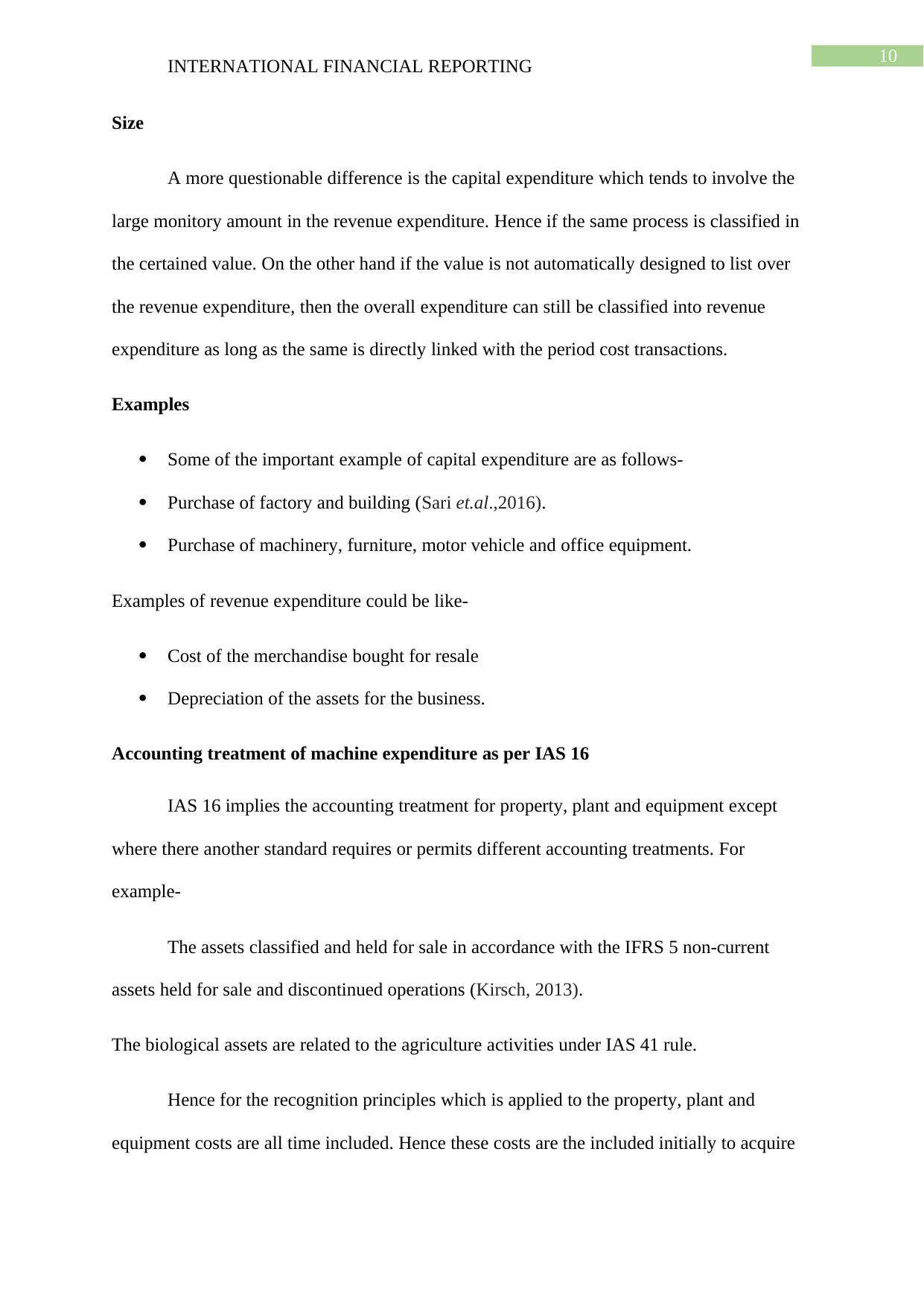
10
INTERNATIONAL FINANCIAL REPORTING
Size
A more questionable difference is the capital expenditure which tends to involve the
large monitory amount in the revenue expenditure. Hence if the same process is classified in
the certained value. On the other hand if the value is not automatically designed to list over
the revenue expenditure, then the overall expenditure can still be classified into revenue
expenditure as long as the same is directly linked with the period cost transactions.
Examples
Some of the important example of capital expenditure are as follows-
Purchase of factory and building (Sari et.al.,2016).
Purchase of machinery, furniture, motor vehicle and office equipment.
Examples of revenue expenditure could be like-
Cost of the merchandise bought for resale
Depreciation of the assets for the business.
Accounting treatment of machine expenditure as per IAS 16
IAS 16 implies the accounting treatment for property, plant and equipment except
where there another standard requires or permits different accounting treatments. For
example-
The assets classified and held for sale in accordance with the IFRS 5 non-current
assets held for sale and discontinued operations (Kirsch, 2013).
The biological assets are related to the agriculture activities under IAS 41 rule.
Hence for the recognition principles which is applied to the property, plant and
equipment costs are all time included. Hence these costs are the included initially to acquire
INTERNATIONAL FINANCIAL REPORTING
Size
A more questionable difference is the capital expenditure which tends to involve the
large monitory amount in the revenue expenditure. Hence if the same process is classified in
the certained value. On the other hand if the value is not automatically designed to list over
the revenue expenditure, then the overall expenditure can still be classified into revenue
expenditure as long as the same is directly linked with the period cost transactions.
Examples
Some of the important example of capital expenditure are as follows-
Purchase of factory and building (Sari et.al.,2016).
Purchase of machinery, furniture, motor vehicle and office equipment.
Examples of revenue expenditure could be like-
Cost of the merchandise bought for resale
Depreciation of the assets for the business.
Accounting treatment of machine expenditure as per IAS 16
IAS 16 implies the accounting treatment for property, plant and equipment except
where there another standard requires or permits different accounting treatments. For
example-
The assets classified and held for sale in accordance with the IFRS 5 non-current
assets held for sale and discontinued operations (Kirsch, 2013).
The biological assets are related to the agriculture activities under IAS 41 rule.
Hence for the recognition principles which is applied to the property, plant and
equipment costs are all time included. Hence these costs are the included initially to acquire

11
INTERNATIONAL FINANCIAL REPORTING
or construct as a property item of which the initial costs are significant in relation to the total
cost of the item which have been initiated generally. Hence as per the IAS 16 rule it is seen
that where there is a chance of included an item of property, plant and equipment and the
costs are included and subsequently been replaced of or serviced over.
Generally the measurement of the cost of the plant, machinery are covered under two
type of model namely –
Cost model: In this model the overall cost value is calculated at the cost less depreciation and
impairment.
Revaluation model: The overall asset value is calculated over the date of revaluation less
subsequent depreciation and impairment.
In the revaluation model the revaluations should be carried out properly and the assets
value are to be added unless the value represents the reversal of the revaluation decrease in
the same assets and the values at the balance sheet date. On the other hand if the assets are
revalued then the entire assets class are to be revalued.
Depreciable value
The depreciable value should be allocated on a systematically basis over the asset
cost. The residual value and the useful life of the machine are been revalued and reviewed in
the financial year ended. Thus if the expected values differ from the actual value then the
same could be generated in the asset value not appropriate. The depreciation value could be
reviewed at the initial stage and if the general value is changed over the depreciation value as
per IAS 8 rule. Hence the expected change in price could be indicating the higher rate of
consumption. Now in response to the query on the accounting treatment for the €420000
expenditure which is not treated as the machine cost it can be said that the value could be
added in the revenue expenditure. Since the initial cash value to capitalise is added to the
INTERNATIONAL FINANCIAL REPORTING
or construct as a property item of which the initial costs are significant in relation to the total
cost of the item which have been initiated generally. Hence as per the IAS 16 rule it is seen
that where there is a chance of included an item of property, plant and equipment and the
costs are included and subsequently been replaced of or serviced over.
Generally the measurement of the cost of the plant, machinery are covered under two
type of model namely –
Cost model: In this model the overall cost value is calculated at the cost less depreciation and
impairment.
Revaluation model: The overall asset value is calculated over the date of revaluation less
subsequent depreciation and impairment.
In the revaluation model the revaluations should be carried out properly and the assets
value are to be added unless the value represents the reversal of the revaluation decrease in
the same assets and the values at the balance sheet date. On the other hand if the assets are
revalued then the entire assets class are to be revalued.
Depreciable value
The depreciable value should be allocated on a systematically basis over the asset
cost. The residual value and the useful life of the machine are been revalued and reviewed in
the financial year ended. Thus if the expected values differ from the actual value then the
same could be generated in the asset value not appropriate. The depreciation value could be
reviewed at the initial stage and if the general value is changed over the depreciation value as
per IAS 8 rule. Hence the expected change in price could be indicating the higher rate of
consumption. Now in response to the query on the accounting treatment for the €420000
expenditure which is not treated as the machine cost it can be said that the value could be
added in the revenue expenditure. Since the initial cash value to capitalise is added to the
⊘ This is a preview!⊘
Do you want full access?
Subscribe today to unlock all pages.

Trusted by 1+ million students worldwide
1 out of 20
Related Documents
Your All-in-One AI-Powered Toolkit for Academic Success.
+13062052269
info@desklib.com
Available 24*7 on WhatsApp / Email
![[object Object]](/_next/static/media/star-bottom.7253800d.svg)
Unlock your academic potential
Copyright © 2020–2025 A2Z Services. All Rights Reserved. Developed and managed by ZUCOL.



